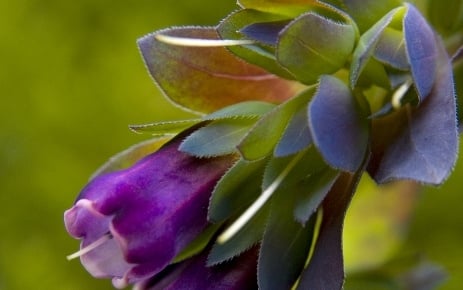

Contributor
- Topics: Archive

I will never forget—perhaps 20 years ago—when I first saw Cerinthe major purpurascens on the cover of the Thompson & Morgan catalog. It was the new “hot” plant. When my order arrived, I planted the seed in a protected area and coddled it for fear it would not germinate. My fussing produced spindly plants that managed to produce seed. And so began a whirlwind Cerinthe takeover. The large black seeds, nearly a quarter inch in diameter, have found their way into my backyard and side yard—even my pots. I don’t know how it manages to travel so far.
Now Cerinthe germinates in the driveway and along the sidewalk, flourishing in both watered and unwatered areas of the garden.
Annie’s Annuals recommends this plant for “beginning gardeners.” Sure, it’s easy to grow. But why torment people for the rest of their gardening lives? On the other hand, nearly every gardener who visits when this plant is in bloom wants it. I understand their fascination with the unusual pendent blossoms; after all, I too, was once seduced by its charms. When they ask how to get the plant, I tell them I’ll share once seeds develop. I have actually seen visitors surreptitiously take a few seeds, and I snicker to myself knowing what they are in for. I suppose I could eradicate them in three or four years if I pulled all the seedlings before they bloomed. But the sight of the blue green leaves emerging after the first fall rain reminds me of their lovely blooms and I just can’t bring myself to wage that war.
Campaigns against aggressive plants are not limited to seed producers. Campanulas are a desirable garden plant whose romantic common name is bellflower. I am overly successful with the low-growing Campanula poscharskyana but, so far, have managed to keep it within bounds. But I find tall campanulas—with the exception of Campanula primulifolia—a challenge.
So it was love at first sight when I encountered Adenophera lillifolia, or ladybells (a campanula relative), at Suncrest Nursery. Grower Nevin Smith described it in their 2002 catalogue as “a robust perennial” with lush crowns of large, tapered leaves topped with three-foot-tall stems bearing dozens of nodding lavender bells. All true, but “robust” was a bit understated. Adenophera is a runner. I would have chosen the word “aggressive,” with virtually no possibility of eradication, unless you Roundup® the whole garden. One can try to pull out the deeply rooted plants but any piece left behind grows back, crowding out bulbs and perennials, and moving in wherever it can. An evergreen perennial, the plant has an upper hand against dormant plants and I must be vigilant in protecting my treasures. However, every year ladybells’ spring blooms seduce me into laying down arms.
One year, a hollyhock managed to serendipitously seed itself right in the middle of the Adenophera. I was prepping for a garden tour and so removed the offending hollyhock leaves which were suffering their typical springtime rust. The lovely apricot hollyhock blossom complemented the deep lavender blooms of the Adenophera so well it was the talk of the tour. Still, I continue my battle with this rampant plant and its efforts to smother perceived competition.
Seductive flowers, luscious leaves, and fabulous seed heads fool us into being their perpetual servants. I’ve always wondered why older gardeners often ended up with less diversity in their gardens. Now I know. They either lost the war to the stronger candidates, or perhaps they grew tired of making decisions.
Share:
Social Media
Garden Futurist Podcast
Most Popular
Videos
Topics
Related Posts

Low Maintenance Gardens – Better for Pollinators and People
Autumn 2022 “I come out every day. It’s therapy, my meditation.” Janet’s young garden transformed from overgrown, invasive plants to mostly natives. The dailiness of

Calochortophilia: A Californian’s Love Affair with a Genus
Summer 2022 I can chart the progression of my life by Calochortus. For the last two decades, at least. As a teenage girl growing up

Pacific Plant People: Carol Bornstein
Spring 2022 Public gardens play a key role in demonstrating naturalistic planting design, selecting native and adapted plants for habitat, and testing techniques for reducing

Add Year-Round Interest and Winter Blooms for Pollinators
Spring 2022 This article was created from an Interview by Merrill Jensen with Neil Bell in the Summer of 2021 for our Pacific Plant People









Responses